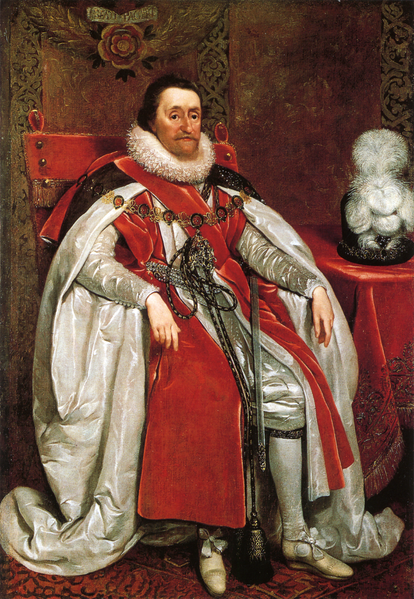In his latest Age of Invention newsletter, Anton Howes discusses how the King of Scotland succeeded to the English throne as well:

King James I (of England) and VI (of Scotland)
Portrait by Daniel Myrtens, 1621 from the National Portrait Gallery via Wikimedia Commons.
It’s late March 1603, and an exhausted messenger arrives in Edinburgh bearing a sapphire ring. He has ridden for over two days straight, over hundreds of miles, and his hair and clothes are matted with blood — on the way he had fallen from his horse, a hoof striking him directly in the head. It’s a miracle he’s alive, but he knows it has been worth it. He is the very first to tell you that your childless first cousin twice removed — the killer of your mother, whom you never knew — is finally dead. You, King James VI of Scotland, are James I of England as well.
[…]
James’s accession was a frenzy. From the very moment of Elizabeth’s death, her entire patronage network was turned on its head. Her chief ministers, the Privy Council, were relatively safe. Some of them had been corresponding with James for years. But they could only look on, anxiously, as a rush of would-be cronies went north to meet their new king. The exhausted messenger with the sapphire ring, Sir Robert Carey, was just the first. Carey had been related to Elizabeth I on her mother’s side — he was her first cousin once removed. (Carey’s grandmother was the “other Boleyn girl”, played by Scarlett Johansson in the 2008 film — although there’s no solid evidence, it’s not totally impossible that Carey was actually related to Elizabeth on her father’s side instead …) But that family connection meant nothing now that the queen was dead.
The sudden reset of the source of all patronage meant that the earlier the access to the new king’s person, the greater the chance of gaining his favour. Carey may have angered the Privy Council by riding ahead of their formal letters to James, but his exertion won him an on-the-spot appointment as a gentleman of the bedchamber, and his wife became a lady in waiting to James’s queen. The Careys were soon charged with the care of the royal couple’s younger sickly child, and when that child eventually became Charles I, Carey was made Earl of Monmouth. Not a bad result for a head wound and a two days’ ride, though I’m sure the horses would disagree. An old proverb about England was that it was “a paradise for women, a purgatory for servants, and a hell for horses” — something that James’s accession really put to the test. One teenage noblewoman reported how she and her mother killed three horses in a single day, pushing them hard despite the heat, in their rush to meet the new queen.
Just as courtiers flocked to James, however, the king wanted to win friends and allies too. So he handed out favours like confetti. Before he had even reigned a single year, he had created 934 knighthoods — already more than the 878 that Elizabeth I, her generals, and her lord deputies in Ireland had created over the course of her entire 45-year reign. One morning, during his journey down to London, James knighted more people than Elizabeth had in her first five years — all before he’d even had his breakfast. The sheer volume of new knighthoods prompted Francis Bacon — one of about 300 to be knighted in London ahead of the coronation — to call it a “divulged and almost prostitute title”.
The same went for peerages. Elizabeth, over her long reign of almost half a century, had created only 18 new titles. James, before he had even been crowned, had already created 12 — mostly turning knights into lords, and raising some lords into earls. Along with the honours came grants of land, annual pensions, and one-off gifts — not only to James’s new English courtiers, but to his old Scottish favourites too. James’s arrival was an explosion of largesse. (Not all were happy about the relative loss of favour, of course […] at least one pro-invention courtier got involved in a treasonous plot against the new king and ended up losing his head.)
James’s largesse even extended to policy. As he triumphantly marched into London, he issued a proclamation to immediately suspend all of Elizabeth’s patent monopolies, to be re-granted pending review. (This did not apply to patents for trading corporations or guilds.) Rather than leaving the validity of patents to be tested in the common-law courts, at great legal cost to those affected, he would have his Privy Council systematically examine them first, only allowing them if they were in the public interest. He characterised it as a continuation — even a “perfecting” — of Elizabeth’s partial measures a couple of years earlier, which we discussed in Part II. With his proclamation also condemning various other unpopular things, like high court fees, his new subjects were overjoyed.
But the honeymoon was not to last.



